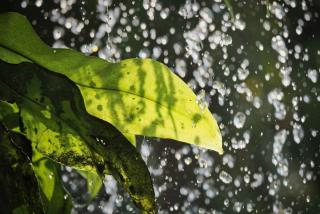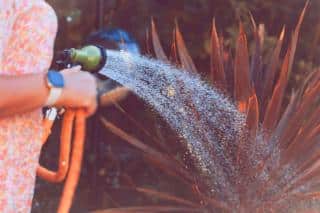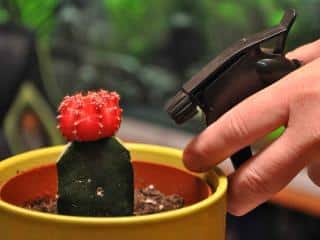

Inside a house, plant’s aren’t any different from furniture… they also gather dust! In time, a layer accumulates on leaves. Day in, day out, and in the end it sticks to the leaves. For plants this is a problem: it blocks photosynthesis and throttles growth. Regular leaf-cleaning will remove dust from leaves.
 A lot of the nutrients plants need come from the soil, but the foliage is where it’s processed thanks to sunlight. Additionally, leaves also have the capacity to capture some nutrients and moisture directly from the air around them.
A lot of the nutrients plants need come from the soil, but the foliage is where it’s processed thanks to sunlight. Additionally, leaves also have the capacity to capture some nutrients and moisture directly from the air around them.
Some plants, such as cactus, Tillandsia, and succulents (like the jade plant) even collect most of what they need from the surrounding air. Of course, any amount of dust will always interfere with this phenomenon: plants become weaker and growth is slowed. Cleaning the leaves is thus as important for the plant as watering and giving fertilizer is.
How to go about it differs from plant to plant because leaves are different, all houseplants need their leaves cleaned at some point. Depending on how fragile leaves are, the options you have are: showering, wiping with a soft cloth, or with a sponge.
 Some plants such as beaucarnea, dieffenbachia, Zamioculcas (keep that raven ZZ plant from turning gray!), philodendron, spathiphyllum, indoor palm trees and yucca are fine with a good shower-down in the bathtub while they’re still easy to carry around. In spring, if the weather is warm enough, you can also bring them out and hose them down with a garden hose.
Some plants such as beaucarnea, dieffenbachia, Zamioculcas (keep that raven ZZ plant from turning gray!), philodendron, spathiphyllum, indoor palm trees and yucca are fine with a good shower-down in the bathtub while they’re still easy to carry around. In spring, if the weather is warm enough, you can also bring them out and hose them down with a garden hose.
Start off with a hand spray bottle, and mist all the leaves to get the layer of dust wet: this will make cleaning it off easier. Then, with a soft, wet cloth or sponge, carefully stroke each leaf clean. Dip the cloth in a bucket of clear water every so often. Take care not to break or damage the leaves! Some plants are very fragile. Crassula, for instance requires a great deal of care. In this case, secure each leaf from below with one hand, and use the other hand to wipe the topside clean. Another option is to use a soft-bristle paintbrush that you dip in water.
There is no need to buy anything for this from garden stores. Using any kind of detergent will inevitably leave small amounts of it on leaves. This deposit might be toxic, or it might trigger diseases. However, there are a few natural options to try out…
Natural products to make leaves shine:
Not a chemical, and still very effective: use a little bit of milk or beer together with water to make leaves shiny and seem to sparkle!
Impossible to hustle these over to the shower! Nor can you clean them with a sponge without damaging them! Begonia, Christmas and other cactus, gloxinia and saintpaulia (the African violet) will do fine if you simply sweep them over with a soft-bristle paintbrush. They key is to do this without any water, but to do it often so that dust doesn’t accumulate into a sticky layer. Cleaning a cactus helps make it flower more, too.
In summer, bring your houseplants outside so that they may get more air; rain will clean them off naturally!